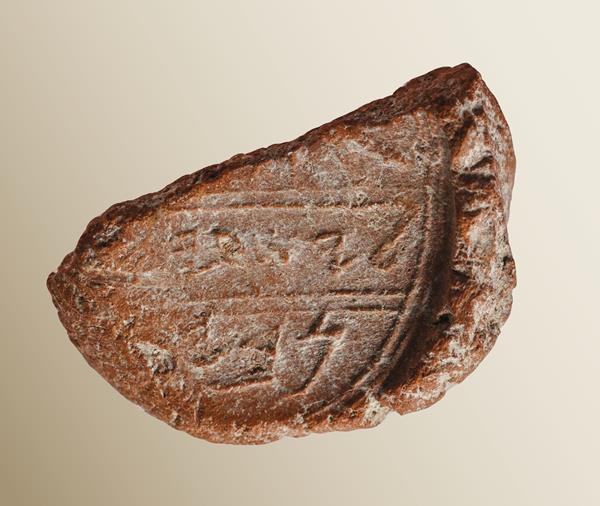A prominent Israeli archaeologist announced this week her discovery of a clay seal bearing the Hebrew name of Isaiah which may very well have belonged to the Biblical prophet.
“We appear to have discovered a seal impression, which may have belonged to the prophet Isaiah, in a scientific, archaeological excavation,” said Dr. Eilat Mazar, an archaeologist from Hebrew University, who made the discovery.
“The clay seal shows the lower part of a grazing doe, a motif of blessing and protection found in Judah, particularly in Jerusalem,” Dr. Mazar wrote in Biblical Archaeology on Wednesday.

It is unclear however, if the seal actually belonged to the prophet Isaiah because it remains uncertain that a letter may or may not be missing.
The [clay impression] reads ‘leyesha‘yah[u]’ in ancient Hebrew letters, which means ‘[belonging] to Isaiah’. The three Hebrew letters of nun, vav, and yud also appear. After the letter yud, the corner of the seal is broken off, raising the question if the three letters were also followed by a fourth letter, aleph completing the word, navi (prophet). Alternatively, the damaged space may very have been blank.
Without that missing corner confirming the existence or absence of the aleph, the bulla cannot be fully determined to have belonged to the Biblical prophet. If it can be authenticated, however, this will be the first time that an artifact directly connected to a Biblical prophet has been found.
The seal was discovered ten feet from where, in 2015, Dr. Mazar found another similar artifact that belonged to King Hezekiah who ruled over Judah from 727 BCE-698 BCE.
“The close relationship between the king and the prophet is well known,” Dr. Mazar told Breaking Israel News. “Finding a seal impression of the prophet Isaiah next to that of King Hezekiah should not be unexpected. It would not be the first time that seal impressions of two Biblical personas were discovered in close proximity.”
Dr. Mazar referred to two seal impressions belonging to Yehukhal ben Sheleḿiyahu ben Shovi and Gedaliyahu ben Pashḥur, both of whom were high officials in King Ẓedekiah’s court. Both seals were found just a few feet apart from each other, in the City of David in 2005. She noted that both were mentioned in the same Biblical verse.
Shephatiah son of Mattan, Gedalia son of Pashhur, Jucal son of Shelemiah, and Pashhur son of Malchiah heard what Yirmiyahu was saying to all the people. Jeremiah 38:1
The seal itself was not used by the common folk and therefore, symbolizes a person’s high stature in society.
“A seal is not an ordinary thing belonging to normal people,” Dr. Mazar explained. “Important people who need a seal had them to seal documents or to seal packages. No other figure was closer to King Hezekiah than the prophet Isaiah so it is an obvious assumption that he would have such a seal. If this seal did belong to him, it would indicate his high status.”
The reverse side of the seal shows the impression of woven cloth. Dr. Mazar suggested that the cloth may have been from a package the prophet was sending, marking it as his own. She suggested an intriguing and significant possibility of what that package may have been.
“This is reminiscent of the story of the Prophet Isaiah healing King Hezekiah with figs,” she elaborated, referring to one such Biblical account.
When Yeshayahu said, “Let them take a cake of figs and apply it to the rash, and he will recover.” Isaiah 38:21
“Perhaps he brought special figs intended for the king and put a seal so that no one would touch it,” Dr. Mazar suggested. “We don’t know but there are many possibilities.”
Remarkably, a fingerprint is visible on the clay, perhaps that Isaiah himself.
“If the owner of the seal was the Prophet Isaiah, we have here the fingerprint of the prophet,” Dr. Mazar said. “But we cannot be sure of this because of the missing Aleph.”
Even the few clues found on the tiny piece of clay give hints that must be considered. Dr. Mazar noted that most seals are identified by the name of the owner and the owner’s father, which in the case of the Prophet Isaiah would be ‘Isaiah the son of Amotz’.
“That is the normal style. however there are cases of seals containing the name and the title,” she said, emphasizing that this also was not a definitive clue. “Navi without an ‘aleph’ could also mean ‘from the city of Nov,’ a Kohanic (priestly) city near Jerusalem mentioned often in the Bible.”
Thereupon the king sent for the KohenAchimelech son of Achituv and for all the Kohanim belonging to his father’s house at Nov. They all came to the king. I Samuel 22:11
One other objection to the possibility that this seal belonged to Isaiah the prophet is the lack of the letter hay as a definitive prefix. In the Bible, the word navi (prophet) is usually preceded by the definitive of hay, translating as “the prophet.” The letter Hay, however, does not appear on the clay impression as a prefix to the letters of nun, vav, bet and yud, indicating that the seal did not say, “the prophet.” Dr. Mazar acknowledged this as a potential sign that the seal impression may not be from Isaiah but also noted that many inscriptions in ancient Hebrew have been found without the prefix.
Although she is not religious, Dr. Mazar uses the Bible as a resource for her research.
“I look for the reality behind the stories since reality is clearly written there, but the bible has to be examined according to the archaeological proof,” she stressed. “I was educated in archaeology to relate to the Bible as a most important historical source, to examine it and re-examine it.”




